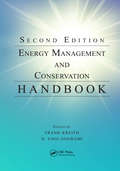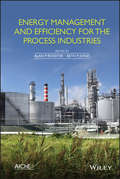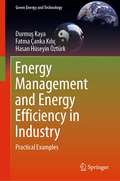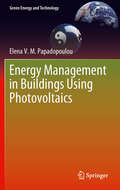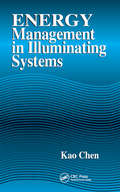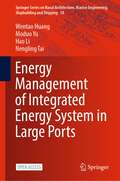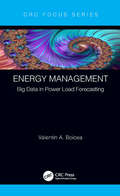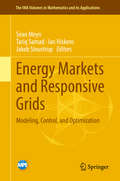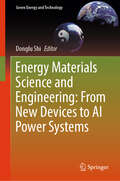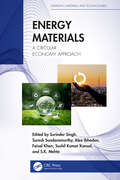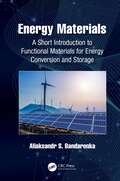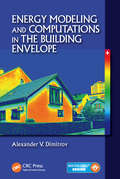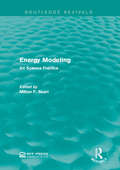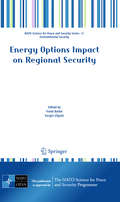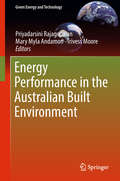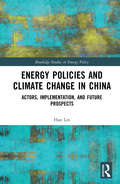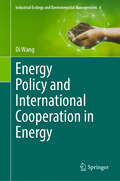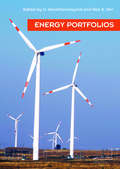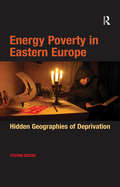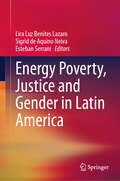- Table View
- List View
Energy Makes Things Happen (Let's-Read-and-Find-Out Science)
by Kimberly Brubaker Bradley Paul MeiselSimple language and humorous illustrations show how energy comes originally from the sun and can be transferred from one thing to another.
Energy Management Strategies for Multi-Vectored Energy Hubs to Achieve Low Carbon Societies
by Sanjeevikumar Padmanaban Rupendra Kumar Pachauri Sivaraman Palanisamy Sharmeela Chenniappan Jai Govind Singh Shubham TiwariComprehensive reference on multi energy hub (MEH) modeling, management, protection, and trading across energy exchange markets with supporting case studies Energy Management Strategies for Multi-Vectored Energy Hubs to Achieve Low Carbon Societies discusses the complex exchange process across different sources within an evolving set of technologies, presenting multi-vectored energy hub (MV-EH) modeling techniques and associated energy management strategies for their network architecture. This includes in-depth assessments of advanced energy conversion technologies, market mechanisms, and transactive energy management to ensure robust and flexible energy-sharing mechanisms. The book focuses on renewable energy integration in MV-EHs, advanced energy storage, and advance energy conversion technologies. Later chapters cover detailed analyses of Power-to-X (P2X) technologies, bioenergy integration, and emerging challenges in high-renewable penetration in energy hubs. Case studies of MV-EHs explore the latest advancements such as the carbon tax mechanism, carbon trading strategies, the role of hydrogen generation, and carbon storage to enhance MV-EH performance. Readers will find insights into the integration of carbon reduction techniques (CDR) and emission trading mechanisms, along with the role of bioenergy in building the low emission energy systems. Mathematical models of various new energy conversion systems such as power to gas (P2X), hydrogen storage, and hydrogen usage are also explored. Edited by a team of highly qualified authors, this book covers additional topics such as: Types of frameworks to manage network energy hubs, cooperative and non-cooperative strategies, and centralized, decentralized, and distributed system architectures Advanced energy conversion units such as electric heat pumps, combined heat and power units, gas boilers, absorption chillers, electric chillers, and energy storage units The role of bioenergy, power-to-X, hydrogen, carbon reduction techniques (CDR), carbon taxes, carbon market, and trading strategies in achieving low energy systems Technologies to enhance flexibility in MEHs such as electrical, heating, cooling, and community demand response programs The impact of high or full share of renewables and load-side uncertainties on MV-EH operations Delivering a thorough understanding of networked multi-vectored energy systems, and their role in sustainable energy transitions, Energy Management Strategies for Multi-Vectored Energy Hubs to Achieve Low Carbon Societies is an essential reference for engineers, researchers, and graduate students developing energy systems, smart grids, and decarbonization strategies.
Energy Management and Conservation Handbook (Mechanical and Aerospace Engineering Series)
by Frank Kreith and D. Yogi GoswamiEnergy is the mainstay of industrial societies, and without an adequate supply of energy the social, political and economic stability of nations is put into jeopardy. With supplies of inexpensive fossil fuels decreasing, and climate change factors becoming more threatening, the need to conserve energy and move steadily to more sustainable energy sources is more urgent than ever before. The updated Second Edition of this successful handbook includes chapters from leading experts on the economics and fiscal management of energy, with a focus on the tools available to advance efficiency and conservation measures. Updated coverage of renewable energy sources, energy storage technologies, energy audits for buildings and building systems, and demand-side management is provided. The appendix of the handbook provides extensive data resources for analysis and calculation.
Energy Management and Efficiency for the Process Industries
by Beth P. Jones Alan P. RossiterProvides a unique overview of energy management for the process industries Provides an overall approach to energy management and places the technical issues that drive energy efficiency in context Combines the perspectives of freewheeling consultants and corporate insiders In two sections, the book provides the organizational framework (Section 1) within which the technical aspects of energy management, described in Section 2, can be most effectively executed Includes success stories from three very different companies that have achieved excellence in their energy management efforts Covers energy management, including the role of the energy manager, designing and implementing energy management programs, energy benchmarking, reporting, and energy management systems Technical topics cover efficiency improvement opportunities in a wide range of utility systems and process equipment types, as well as techniques to improve process design and operation
Energy Management and Energy Efficiency in Industry: Practical Examples (Green Energy and Technology)
by Durmuş Kaya Fatma Çanka Kılıç Hasan Hüseyin ÖztürkThis book is presented to demonstrate how energy efficiency can be achieved in existing systems or in the design of a new system, as well as a guide for energy savings opportunities. Accordingly, the content of the book has been enriched with many examples applied in the industry. Thus, it is aimed to provide energy savings by successfully managing the energy in the readers’ own businesses. The authors primarily present the necessary measurement techniques and measurement tools to be used for energy saving, as well as how to evaluate the methods that can be used for improvements in systems. The book also provides information on how to calculate the investments to be made for these necessary improvements and the payback periods. The book covers topics such as: • Reducing unit production costs by ensuring the reduction of energy costs, • Efficient and quality energy use, • Meeting market needs while maintaining competitive conditions, • Ensuring the protection of the environment by reducing CO2 and CO emissions with energy saving and energy efficiency, • Ensuring the correct usage of systems by carrying out energy audits. In summary, this book explains how to effectively design energy systems and manage energy to increase energy savings. In addition, the study has been strengthened by giving some case studies and their results in the fields of intensive energy consumption in industry. This book is an ideal resource for practitioners, engineers, researchers, academics, employees and investors in the fields of energy, energy management, energy efficiency and energy saving.
Energy Management in Buildings Using Photovoltaics
by Elena PapadopoulouAlthough fossil fuels remain the primary global energy source, developing and expanding economies are creating an ever-widening gap between supply and demand. Efficient energy management offers a cost-effective opportunity for both industrialized and developing nations to limit the enormous financial and environmental costs associated with burning fossil fuels. The implication of photovoltaic systems in particular presents the potential for clean and sustainable electrical energy to be generated from an unrestricted source. Energy Management in Buildings Using Photovoltaics demonstrates how adopting 'best practices' for energy management and harvesting can reduce the need to construct new generating facilities. Illustrated with figures, tables and photos, Energy Management in Buildings Using Photovoltaics provides an introduction and step by step instructions on designing and planning photovoltaic systems and energy policies for both residential and industrial buildings. With particular focus on the example of provided by European industry, the creation of energy efficient systems is explored including chapters on: Zero Energy Buildings, Photovoltaics Technology, and Connection of the Network By presenting this topic from basic introduction to highly technical analysis, Energy Management in Buildings Using Photovoltaics acts a study guide for postgraduate students as well as a key point of reference for researchers and technical consultants in the field of photovoltaic systems.
Energy Management in Illuminating Systems
by Kao ChenAs our dependence on and need for abundant energy grows, it becomes increasingly important for engineers and managers to develop and maintain energy efficient systems and build effective energy management programs. Energy Management in Illuminating Systems presents the latest concepts, innovative methods, and state-of-the art technologies in commercial or industrial lighting systems and energy management.An effective energy management program comprises three essential elements: organization, technology, and economics. However, the success of any management program clearly must begin with an energy effective illuminating system, which in turn depends upon using sound engineering analysis and design principles during the projects early stages. In this book, the author-with long and unique experience in the field-provides the details of proven methods for achieving these goals. He presents:How to organize and operate the illumination energy management programThe elements of designing energy effective illuminating systems-systems that can also increase worker productivity and reduce operating costsThe latest in efficient system components, including light sources, ballasts, and luminairesHow to evaluate energy efficiency, including discussion of the impact of energy efficient equipment on power quality, harmonics, the ""K"" factor, and lighting energy standards Energy Management in Illuminating Systems shows how to design and manage energy effective lighting systems for industrial or commercial facilities. With this book, designers, engineers, and managers finally have a complete, how-to guide for applying practical energy management principles to various systems of illumination.
Energy Management of Integrated Energy System in Large Ports (Springer Series on Naval Architecture, Marine Engineering, Shipbuilding and Shipping #18)
by Hao Li Wentao Huang Moduo Yu Nengling TaiThis open access book provides a detailed exploration of energy management in seaport integrated energy systems, highlighting their potential to replace conventional fuel-based energy usage and promote sustainable development of large ports. In order to achieve carbon neutrality, energy management technologies are crucial for the sustainable development of port systems that couple energies, logistics, and maritime transportation. Research on seaport integrated energy systems has attracted scholars and scientists from various disciplines, such as port electrification, logistics, microgrids, renewable energies, energy storages, and port automation. Taking a holistic approach, this book establishes a fundamental framework for the topic and discusses the electrification process, coupling mechanisms and modeling, optimal planning, low-carbon and economic operation, as well as applications of integrated energy systems in seaports. This book is intended for researchers, graduate students, and other readers interested in green seaport energy management and low-carbon operation technologies under the coupling between logistics and multi-energy systems.
Energy Management: Big Data in Power Load Forecasting
by Valentin A. BoiceaThis book introduces the principle of carrying out a medium-term load forecast (MTLF) at power system level, based on the Big Data concept and Convolutionary Neural Network (CNNs). It also presents further research directions in the field of Deep Learning techniques and Big Data, as well as how these two concepts are used in power engineering. Efficient processing and accuracy of Big Data in the load forecast in power engineering leads to a significant improvement in the consumption pattern of the client and, implicitly, a better consumer awareness. At the same time, new energy services and new lines of business can be developed. The book will be of interest to electrical engineers, power engineers, and energy services professionals.
Energy Management: Conservation and Audits
by Anil Kumar Om Prakash Prashant Singh Chauhan Samsher GautamEnergy Management: Conservation and Audit discusses the energy scenario, including energy conservation, management, and audit, along with the methodology supported by industrial examples. Energy economics of systems has been elaborated with concepts of life cycle assessment and costing, and rate of return. Topics such as energy storage, co-generation, and waste heat recovery to energy efficiency have discussed. The challenges faced in conserving energy sources (steam and electricity) have elaborated along with the improvements in the lighting sector. Further, it covers optimization procedures for the development in the industry related to energy conservation. The researchers, senior undergraduate, and graduate students focused on Energy Management, Sustainable Energy, Renewable Energy, Energy Audits, and Energy Conservation. This book covers current information related to energy management and includes energy audit and review all the leading equipment (boilers, CHP, pumps, heat exchangers) as well as procedural frameworks (energy audits, action planning, monitoring). It includes energy production and management from an industrial perspective, along with highlighting the various processes involved in energy conservation and auditing in various sectors and associated methods. It also explores future energy options and directions for energy security and sustainability.
Energy Markets and Responsive Grids: Modeling, Control, and Optimization (The IMA Volumes in Mathematics and its Applications #162)
by Tariq Samad Sean Meyn Ian Hiskens Jakob StoustrupThis volume consists of selected essays by participants of the workshop Control at Large Scales: Energy Markets and Responsive Grids held at the Institute for Mathematics and its Applications, Minneapolis, Minnesota, U.S.A. from May 9-13, 2016. The workshop brought together a diverse group of experts to discuss current and future challenges in energy markets and controls, along with potential solutions. The volume includes chapters on significant challenges in the design of markets and incentives, integration of renewable energy and energy storage, risk management and resilience, and distributed and multi-scale optimization and control. Contributors include leading experts from academia and industry in power systems and markets as well as control science and engineering. This volume will be of use to experts and newcomers interested in all aspects of the challenges facing the creation of a more sustainable electricity infrastructure, in areas such as distributed and stochastic optimization and control, stability theory, economics, policy, and financial mathematics, as well as in all aspects of power system operation.
Energy Materials Science and Engineering: From New Devices to AI Power Systems (Green Energy and Technology)
by Donglu ShiThis book explores cutting-edge advancements in sustainable energy. It is written by leading experts in the field, covering topics such as advanced energy materials—including organic solar cells and manganese-based batteries—alongside breakthroughs in energy conversion, storage, and AI applications. It demonstrates how superconducting power transmission and AI algorithms are revolutionizing power systems and explores strategies for integrating energy solutions into sustainable urban infrastructure. The book equips researchers, engineers, and policymakers with the knowledge to navigate the complexities of modern energy challenges.
Energy Materials: A Circular Economy Approach (Emerging Materials and Technologies)
by Surinder Singh Faisal Khan Suresh Sundaramurthy Alex Ibhadon Sushil Kumar Kansal S. K. MehtaEnergy Materials: A Circular Economy Approach emphasizes the engineering scalability of a circular economy approach to development and use of energy materials. It focuses on waste minimization and its valorization, recycling and reuse, and emerging sustainable materials and technologies. It offers a view of the eco-friendly energy materials and state-of-the-art technologies required for production of these materials in the process industry and manufacturing sectors.• Covers fundamentals, concepts, and current initiatives within the circular economy• Outlines technologies and materials with specific applications for energy systems, sustainability aspects and societal benefits• Focuses on detailed aspects of processing of energy materials, kinetics, their utilization, and end-of-life management and application of circular economy in waste utilization and valorization• Discusses technologies, processing methods, and production of materials related to fuel cells, super capacitors and battery materials, carbon based hetrostructures, catalysis, functional materials, nanotechnology, biofuels, solar and wind energy, and valuable chemicals• Details topics related to synthesis and application of energy materials, their recycle, reuse, and life cycleThis book is aimed at students, researchers and professional engineers and scientists working in chemical, materials, energy, and environmental engineering, as well as materials chemistry.
Energy Materials: A Short Introduction to Functional Materials for Energy Conversion and Storage
by Aliaksandr S. BandarenkaEnergy Materials: A Short Introduction to Functional Materials for Energy Conversion and Storage provides readers with an accessible overview of the functional materials currently employed or investigated for energy provision, conversion, and storage. Rather than exploring the physical and chemical basics of energy conversion and storage, this book focuses on the various materials used in this field with simple explanations of their design principles, specific functionality, and quantitative figures of merit. It is suited for advanced undergraduate and graduate students studying energy and energy materials in physics, material science, engineering, and chemistry courses, as well as scientists starting their research in the field of functional materials for energy applications. Key Features: Provides an accessible introduction to complex subjects in simple terms with pedagogical features to enhance learning Contains the latest developments in this exciting and growing area Discusses examples from modern high-impact research and applications
Energy Modeling and Computations in the Building Envelope
by Alexander V. DimitrovEnergy Modeling and Computations in the Building Envelope instills a deeper understanding of the energy interactions between buildings and the environment, based on the analysis of transfer processes operating in the building envelope components at the microscopic level. The author:Proposes a generalized physics model that describes these interacti
Energy Modeling: Art Science Practice (Routledge Revivals)
by Milton F. SearlIn 1973, a seminar was held by Resources for the Future to bring together the new and growing community of scholars researching into the general field of energy modelling. Originally published in the same year, this report gathers together all of the papers presented at that seminar in order to further spread the results of these studies with those who were unable to attend. The papers cover a full range of techniques used for energy modelling whilst commenting on current government and industry models. This title will be of interest to students of Environmental Studies.
Energy Options Impact on Regional Security
by Sergio Ulgiati Frano BarbirThis book addresses energy-related issues in light of the options available to the European and Mediterranean countries. The articles attempt to identify and analyse the economic, environmental, societal and regional security issues that may emerge from those options. It is clear that a coherent energy strategy is required, addressing energy supply and demand, security of access, financial issues, market dynamics, and also taking into account the whole energy lifecycle including fuel production, transmission and distribution. In the short term, the aim should be to achieve higher energy efficiencies and increased supply from local energy sources, in particular renewable energy sources. In the long term, redesign of life styles, further increase of alternative energy sources and shift to new energy technologies and carriers is expected to contribute to solve or alleviate the problems generated by declining availability of fossil fuels. In this volume, energy experts provide background information and a detailed discussion of all these issues and strategies.
Energy Performance in the Australian Built Environment (Green Energy and Technology)
by Trivess Moore Priyadarsini Rajagopalan Mary Myla AndamonThis book examines energy efficiency in the Australian built environment and presents current developments with a particular focus on the temperate setting of Victoria state. It is divided into four main parts discussing policies, climate, and carbon footprint and presenting case studies on the energy performance and indoor environmental quality of various building types. The book is intended for readers wanting to understand the various policies related to different buildings types and their energy performance.
Energy Policies and Climate Change in China: Actors, Implementation, and Future Prospects (Routledge Studies in Energy Policy)
by Han LinIn the face of growing environmental challenges, including climate change and energy security, countries across the globe are developing new policies and programs to address these challenges, and China is no exception. This book analyses China’s two most significant climate-related energy policies, the Clean Development Mechanism (CDM; including the later Chinese Certified Emission Reduciton – CCER) and the Energy Conservation and Emission Reduction Scheme (ECERS). This work specifically examines the strengths and weaknesses of these policies to highlight the deficiencies and advise how they can be optimised, so China can better achieve its emission reduction goals. It analyses the roles and relationships between relevant actors and identifies how successful their cooperation has been, and what factors have affected it. Importantly, the work draws on a wide range of sources from central ministries to civil society, including interviews with Chinese officials, scholars, energy company managers, environment non-govermental organisation (ENGO) personnel, media reports, and online forum discussions. In doing so, the book not only analyses the thoughts of policymakers, as many works do, but also those implementing the policies and those impacted by the policies. The book concludes by offering detailed and practical solutions to address each specific deficiency in the CDM and ECERS policies, with the aim of providing innovations and alternative approaches to improve current and future policies in China. This book will be of great interest to students, scholars, and policymakers interested in climate change, energy, and Chinese environmental policy and politics.
Energy Policy and International Cooperation in Energy (Industrial Ecology and Environmental Management #6)
by Di WangThis book presents a scientifically rigorous methodology that incorporates multidisciplinary, multi-dimensional, multi-agent, and multi-perspective approaches to energy policy and international energy cooperation. It offers an in-depth analysis of fundamental theories and conducts comprehensive research on the energy policies of ten major global producers and consumers. Through a detailed examination, the book explores the impact of these policies on international cooperation. Key concepts include the exploration of foundational theories from a multidisciplinary perspective, systematic analysis of energy policies within a five-dimensional framework, and the organization of typical cases of international energy cooperation. The book highlights the roles of bilateral and multilateral alliances and examines the effects of energy policies through various dimensions such as legal regulations and fiscal tools. By addressing these critical issues, it provides valuable insights into the dynamic interplay between energy policy and international cooperation. <span lang="EN-US" style="font-size: 11.0pt; font-family: 'Calibri',sans-serif; mso-as
Energy Portfolios
by U. Aswathanarayana Rao S. DiviThis book provides an overview of the globally ongoing research and development efforts to reduce carbon emissions and costs, and to improve the efficiency of emerging energy technologies. It covers current and future research and development of Coal, Oil, Natural Gas, Nuclear Power, and Renewable Energy Resources. The author provides optimal size,
Energy Poverty in Eastern Europe: Hidden Geographies of Deprivation
by Stefan BuzarOne of the consequences of the post-socialist transformation of Eastern and Central Europe and the Former Soviet Union is the emergence of energy poverty, a condition where households are living in inadequately heated homes. This book provides the first full-length examination of the causes, consequences and patterns of energy poverty in former Communist countries. Based on empirical evidence that spans different spatial contexts and scales and compares these with other parts of the world, the book links household-level deprivation with broader organizational and political dynamics. The book also analyzes the lived experiences of scarcity and marginalization with the aid of two in-depth country studies. Furthermore, it identifies the socio-demographic factors that distinguish energy-poor families from the rest of the population, while stressing the need for a comprehensive range of policy tools to address energy poverty. As the issue of energy supply from the former Soviet Union is likely to become one of the most important economic and political problems across the whole of Europe within the next couple of decades, the book argues that there is a direct link between the energy crises experienced by the region, and the social aspects of energy use in households.
Energy Poverty, Justice and Gender in Latin America
by Lira Luz Benites Lazaro Esteban Serrani Sigrid de Aquino NeivaThis book presents a comprehensive examination of the pivotal challenges and viewpoints about energy poverty, energy justice, and gender diversity challenges within the Latin American energy transition context. Notwithstanding the discourse of progress on energy access espoused by some governments, a considerable number of communities in the region continue to lack reliable electricity, thereby emphasizing a glaring disparity in the distribution of benefits and burdens. Through a nuanced and incisive lens, this book explores the complex landscape of inequality and opportunity, emphasizing the urgent need for inclusive action and systemic transformation. The book employs an interdisciplinary methodology, integrating insights from energy policy, social justice, and gender studies to provide a comprehensive analysis of the complex interrelationship between these domains. It examines the intersection between energy poverty and broader social inequalities, particularly gender disparities, and highlights the necessity for solutions that prioritize the most vulnerable communities. By integrating case studies, real-world examples, and expert analysis, the book offers a more nuanced understanding of the barriers and opportunities for progress. The book offers practical policy recommendations and actionable strategies, making it an invaluable resource for policymakers, NGOs, academics, and stakeholders dedicated to fostering an inclusive, sustainable, and just energy transition in Latin America. It encourages readers to reconsider traditional approaches and to advocate for a new vision where energy justice and gender equality are paramount in the region's development.



